SATURNIA PAVONIA LIGURICA
(WEISMANN, 1876)
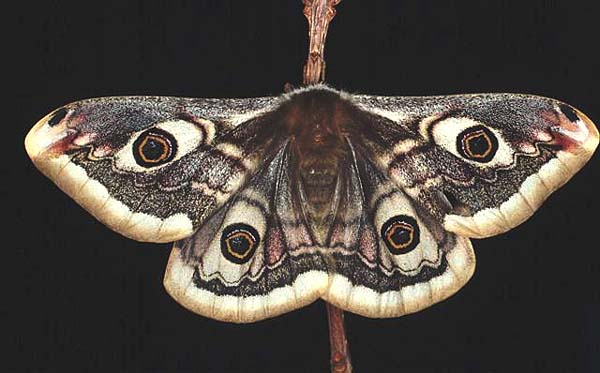
Female Saturnia pavonia ligurica courtesy of Mario Ioppolo.
Most of the information on this page is courtesy of Tony Pittaway.All images on this page are courtesy of Mario Ioppolo.
| TAXONOMY:Superfamily: Bombycoidea, Latreille, 1802
Family: Saturniidae, Boisduval, [1837] 1834
Subfamily: Saturniinae, Boisduval, [1837] 1834
Tribe: Saturniini, Boisduval, [1837] 1834
Genus: Saturnia, Schrank, 1802
| |
MIDI MUSIC
"Moon River"
copyright C. Odenkirk
MIDI CITYON.OFF
<bgsound src="moon.mid" LOOP=FOREVER>
|
DISTRIBUTON:
Saturnia pavonia ligurica (wingspan 45-95 mm), flies in northern and central Spain, southern France, Italy, southeastern Europe, northern Turkey to the Caucasus Mountains.
FLIGHT TIMES AND PREFERRED FOOD PLANTS:
When spring is early, pavonia ligurica will be on the wing from late February to March.
Males are diurnal and females are nocturnal.
ECLOSION, SCENTING, AND MATING:
Females emerge in the morning and extend a scent gland from the base of the abdomen to "call"
in the more colorful males. Females continue scenting until near noon or until mating.
Many
breeders are able to locate females by following the day-flying males to the source of
attraction.
Females remain coupled with males until nightfall when they seperate, begin
flight, and deposit their eggs.
EGGS, LARVAE, COCOONS, AND PUPAE:
Grayish, medium-sized (1.4 x 2.2mm) eggs with olive-brown gum
are deposited in neat clusters on
the undersides of foodplant leaves or in rings of host plant twigs. Incubation lasts 10-14 days. | 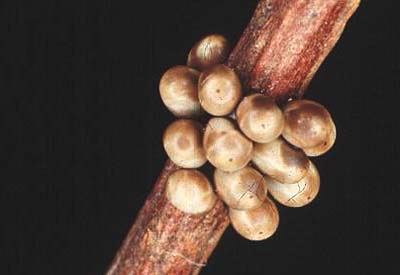 |
When the black, spiny larvae (2-3 mm) first emerge, they devour a portion of their eggshells before
clustering. There is an orange line down each side which is quite pronounced in the second instar larva to the right. |
 |
As the larvae progress they begin to
live more individual
lives and change colour from black to green with yellow tubercles.Tufts of black spines emanate from raised protuberances on the body. | 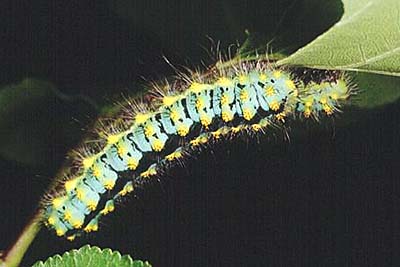 |
Larvae progress through six instars and the fifth instar larva to the right
still has some growing to do. | 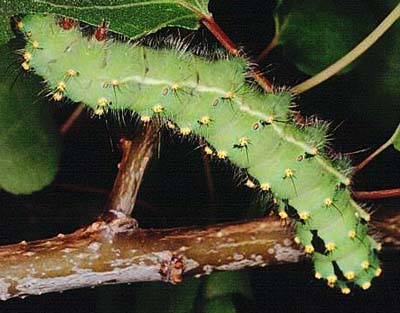 |
In the final instar (67-88 mm) larvae are predominantly
green but there can be varying degrees of black pigmentation with some larvae being almost
completely black.This sixth instar larva has begun to spin among the branches of an apricot tree. | 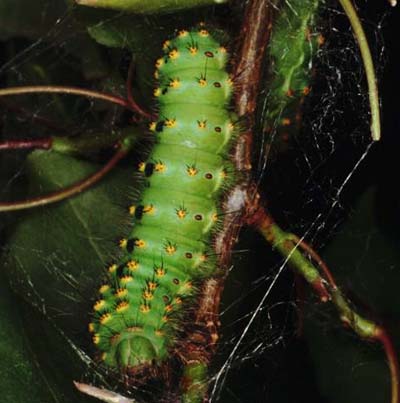 |
Sturdy, coarse, thin-walled, pear-shaped, double, unsealed brown valved cocoons are spun up among
tree leaves. This freshly spun cocoon will shortly darken. | 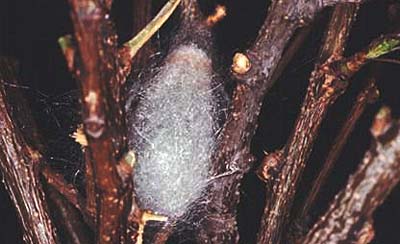 |
Pupae (20-25 mm)sometimes remain in
diapause through two winters. The pupae are dark brown to black, noticeably
dorso-ventrally flattened, and 'comma'-shaped.
Generally speaking, this is an easy moth to rear provided overcrowding
is avoided.
Listed below are 1)the primary food plant(s) used by myself (listed
first); and 2) preferred and alternate food plants listed in Stephen E.
Stone's Foodplants of World Saturniidae. It is hoped that this
alphabetical listing followed by the common name of the foodplant will
prove useful. The list is not exhaustive. Experimenting with closely
related foodplants is worthwhile. Starred items are successfully used by
my father, Don Oehlke, in New Jersey.
Larval Food Plants
Alnus
Arbutus unedo
Betula
Calluna vulgaris
Cornus
Crataegus
Erica
Fagus
Fragaria
Fraxinus
Hippophae rhamnoides
Humulus
Juglans
Lythrum salicaria
Myrica gale
Pistacia terebinthus
Potentilla
Prunus domestica
Prunus serotina
Prunus spinosa
Prunus virginiana
Pyrus communis
Pyrus malus
Quercus
Rosa
Rubus idaeus
Rumex
Salix babylonica
Sambucus
Schinus terebinthifolius
Sorbus
Spiraea alba
Ulmus
Vaccinium myrtillus
|
Alder
Strawberry madrone
Birch
Scottish heathers
Dogwood
Hawthorn
Heath
beech
Strawberry
Ash
Sallow thorn
Hops
Walnut
Loosestrife
Sweetgale
Cyprus/Terpentine
Cinquefoil
Garden plum
Wild black cherry
Blackthorn
Choke cherry
Pear
Apple
Oak
Rose
Wild red raspberry
Sorrel
weeping willow
Elderberry
Brazil peppertree
Mountain ash
Meadow spiraea
Elm
Thinleaf huckleberry
|
This moth has also been classified as follows:
meridionalis Calberla, 1887.
valcarceli Agenjo, 1970.
cosmicae Nadal, 1978
iberligurica Gómez Bustillo et al.
Return to Photography submissions
Return to Main Index






